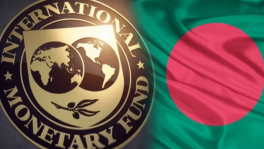Are banks only gainers from dollar crisis?
Taka fell to 87.50 per dollar on Monday from Tk86.70 the previous day
As the dollar rally continues with taka shedding 80 paisa in interbank rate on Monday, it is the banks who stand to gain from the widening gap between official and open market rates.
When the whole country has been suffering from high inflation amid global price hikes, some banks are making money by selling dollars at higher prices to importers and at lower prices to exporters, exacerbating the foreign exchange market crisis.
Banks have been settling import payments at Tk95 to Tk97 per dollar, excusing dollar shortage when the official LC (Letter of Credit) rate is Tk87.50. However, in case of export settlement, exporters are being offered the official rate against their dollar earnings by lenders.
This is how some banks are making business from the price difference of import and export rates when consumers are bearing the cost of import-led inflation.
Fixed lending rate also created imbalance in pricing, prompting banks to involve in undue business amid dollar crisis as they could not raise the loan rate balancing with the rising loan demand, say industry insiders.
The single digit 9% lending rate encourages importers to open more LCs, creating dollar shortage, said a senior executive of the Bangladesh Bank.

In this situation, Bangladesh has been devaluating taka to reduce the gap between the official rate and the market rate of dollars.
In the latest development, the central bank on Monday devalued taka by 80 paisa against each dollar, the biggest single-day decline and the third in the last 20 days.
The interbank exchange rate increased to Tk87.50 per dollar on Monday from Tk86.70 previous day, according to Bangladesh Bank data.
Businesses, consumers are losers
All except banks are feeling the pinch amid the ongoing dollar crisis, said Mohammad Hatem, executive president at Bangladesh Knitwear Manufacturers and Exporters Association (BKMEA).
For example, businesses are having to pay higher than the central bank-set rate against dollars when it comes to import payments, while export earnings they receive are being paid as per the fixed rate, he also said.
Besides, expatriates are not getting remittance earnings at the increased rate against dollars, he added.
They have to open import LCs at around Tk95 per dollar. Banks are cashing in on the dollar shortage with the Bangladesh Bank apparently having no control over the dollar rate, he said.
The extra spending on opening import LCs will eventually be passed on to consumers, further stoking inflation, Mohammad Hatem noted.
Khorshed Alam, chairman at Little Star Group, told TBS, "We are being forced to open a LC at a higher rate because of the dollar shortage."
Kamruzzaman Kamal, director of Pran-RFL Group, said, "We cannot at times pass the entire cost burden on to consumers. So, we need to cut our profit margins."
When contacted, Syed Mahbubur Rahman, managing director at Mutual Trust Bank, said only some banks are making money by capitalising on the dollar crisis, not all.
Lenders offer dollar prices to importers and exporters based on customer-bank relationships, he noted.
Banks are buying dollars at high prices from remitters too. Citing an instance of a private bank, he said they were not getting dollars from remitters even after offering Tk95 per dollar.
On the condition of anonymity, another banker said importers have been settling payments at Tk95 against each dollar, which already has an impact on inflation. So, local currency has been devalued at that rate. There will be no further impact on inflation, rather it will help to control the unhealthy business practice and make exporters gainer.
Seeking to be unnamed, a top executive at a private bank said it is somewhat true that some banks are making money, taking advantage of the dollar crisis.
Mainly, small exporters, who do not have bargaining power, are being losers, he also said.
There should be a standard margin between selling and buying prices to control unethical practice.
However, Bangladesh Bank officials are denying the claim of a gap between import and export rates of dollars.
Giving an example, a Bangladesh Bank official said, an exporter settled exports worth $1 million at Tk93 per dollar last week.
Some small exporters may get lower prices as payments are settled based on bank-customer relationship, he also said, adding that the Bangladesh Bank has not received any complaints from exporters.
The foreign exchange market situation
In the interbank exchange market, taka fell to 87.50 per dollar on Monday from Tk86.70 a day before. Local currency traded at Tk86.45 on 10 May and Tk86.2 on 27 April. The central bank also raised interbank euro exchange rate by 83 paisa to Tk91.03.
Customers have to pay at least Tk5-Tk7 more per dollar. Most banks are selling dollars to customers at Tk90-Tk92. In the kerb market, it is being sold at Tk92-93.
The local currency has been losing its value against the greenback because of increasing value of imports on the back of spiralling global prices of goods further triggered by the Russia-Ukraine war.
Dollar price volatility is making taka weaker than other currencies too, giving some gains to remittance earners as well.
Relatives of Ayub Ali, a Bangladeshi migrant in the United Arab Emirates, got Tk0.40 more per UAE dirham on Sunday. "I sent an amount at an exchange rate of Tk25.90 per UAE dirham. The rate was 25.50 a few days ago," he told TBS on Monday.
Bangladesh's currency lost Tk1.30 in value against a dollar in inter-bank trade, from Tk86.20 to Tk87.50 per dollar, in less than two months, while the greenback is traded at Tk95-96 in informal market, which was Tk90-91 before Eid. For importers, the goods bought in April for $1000 will cost now Tk95-96000, and customers will bear the inflated cost.
Global studies suggest that the fluctuation of exchange rates has negative impacts on external trade, investment, capital market, inflation and employment growth in countries with weak financial market. Economists stress that the central bank needs to step in to keep exchange rates stable to check inflation and ensure faster growth.
Former central bank governor Dr Salehuddin Ahmed told TBS last week in such a situation local currency needs to be devalued to some extent to help exports stay competitive.
To reduce demand for dollar, the central bank raised letter of credit (LC) margins for luxury imports and the finance ministry shelved low-priority development projects and suspended foreign tours of government officials. Raising interest rate and customs duties are among other monetary and fiscal steps left for checking imports of less-important commodities and thus cooling the exchange market.
Md Serajul Islam, executive director and spokesperson at the Bangladesh Bank, said, "Our import payments are higher than what we earn through exports, resulting in pressure on dollars. Considering the market situation, we fixed the dollar rate at Tk87.5."
Exports were on the rise, with remittances reaching $200 million during Eid. Besides, the Bangladesh Bank is supplying dollars as per demand from banks. The central bank has so far sold $5 billion to banks against their needs, he also said.
The Bangladesh Bank is providing dollars to banks whenever necessary, he noted.
Regarding steps against selling dollars at higher than the fixed rate, the central bank's spokesperson said banks are having to buy dollars from the open market at higher rates because of not getting greenbacks as per necessity.
"We hope that it will be adjusted in a few days," he added.
A central bank senior official said the dollar rate should rise further considering the market. The central bank will raise it to Tk90 in the near future.
"But the rate at which remittances are coming to us will lead to a further fall in reserves. In this case, we have to give importance to import substitution and make expatriates more efficient," he added.
Forex reserves under pressure
As demand for the dollar rose due to increased imports, the central bank started selling dollars as per the demand, releasing $5.11 billion to banks till 12 May. In FY21, the central bank purchased around $8 billion from banks.
In the meantime, forex reserves are facing pressure because of a rise in imports in post-pandemic times and their higher payments caused by rising product prices in the international market.
The country's reserves, which reached $48 billion in August last year, dropped to $41.93 billion on 11 May.
In July-March of FY22, exports registered about 33% growth, but it could not hold back trade balance that slid into a deficit of about $25 billion, which was 9% higher than that of the whole previous fiscal year.
The current account is also in the red, with a deficit having exceeded $14 billion despite some growth in remittances in recent months.


 Keep updated, follow The Business Standard's Google news channel
Keep updated, follow The Business Standard's Google news channel















